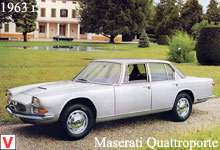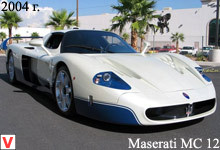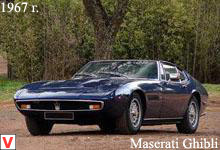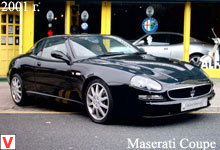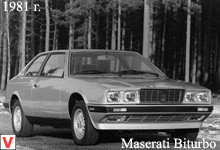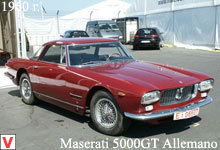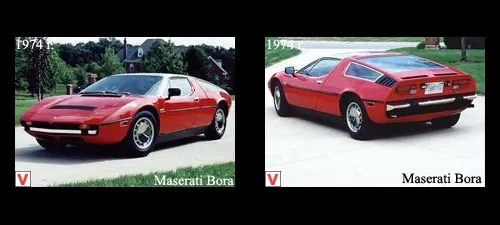
In March 1971, the Maserati Bora makes its debut at the Geneva Motor Show, undoubtedly one of the most beautiful and legendary cars. Giorgetto Giugiaro himself worked on the creation of the body in the company ItalDesign. The shape of this model was distinguished by its elegance and beauty. Bora was low (height was only 1.15 m), with a sharp nose in profile and sharply severed tail.
The door received a deep slant forward, as if repeating the contour of the seat. On a powerful middle rack located hatch neck gas tank with a miniature lock. Right behind the bar is a long triangular glass that extends as far as the stern. Behind the rear, Bora demonstrates laconic lanterns, a modest chrome-plated bumper strip and four exhaust pipes sticking out. The retractable headlights hidden in the engine compartment are duplicated by a pair of powerful fog lamps. This chopped rectilinear style will in time become the signature handwriting of Maestro Giugiaro. The style of the two-seat coupe Bora became a classic of the 70s.
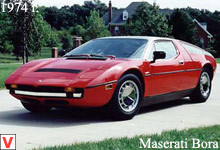
The interior was made in the traditional style of Maserati - two-tone leather upholstery of the dashboard and seats. The cabin is quite spacious for a car of this kind. Visibility from the driver is beyond praise. The steering wheel was adjusted for the angle of inclination and for departure, but the driver's seat could not be moved, but this was partly offset by the adjustable pedal assembly. The analog instrument of the Italian company Veglia is installed on the dashboard: speedometer, tachometer, oil pressure gauge, oil temperature, coolant temperature, fuel gauge and battery charge indicator.
By the way, the famous Maserati watches on the Bora model were still unremarkable - a black circle among other pointers of the same type. On the center console are located the control buttons for power windows, air conditioning and radio. To reduce the noise of the engine in the cabin, all Bora were equipped with an aluminum panel with carpet, which hid under the power unit.
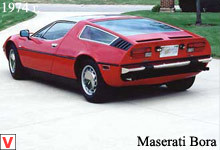
Between the cabin and the engine compartment was an additional glass partition. The boot capacity was 283 liters. The first few cars received aluminum bodies, then they were made of steel. The carrier body of the body was a steel platform with tubular amplifiers.
The engine and transmission were located on a separate vibration-proof stretcher. This solution made it possible to avoid excess weight (the mass of the machine is not more than 1.5 tons) and at the same time left freedom for the subsequent transformations of the body. Special attention deserves the heart of Maserati Bora. The model received a classic engine company - V-shaped, eight-cylinder, 4.7 liters of displacement, with four camshafts and 32 valves (4 per cylinder), 310 hp. at 6000 rpm and 461 Nm of torque at 4200 rpm.
With this engine, the coupe accelerated from zero to a hundred in 6.5 seconds. The maximum speed reached 265 km / h. On the possibilities of this engine says this fact - on the 2nd gear the car could move at a speed of 128 km / h. Despite the complexity of the design, the motor was light (made entirely of aluminum alloys) and compact due to the small angle (200) between the intake and exhaust valves. Since 1973, a 4.9-liter engine from the Ghilbi model with exhaust emission control was installed on the car, thanks to which the coupe could be exported to the USA. Motor power decreased to 300 hp at 6000 rpm, and the torque dropped to 420 Nm at 3500 rpm.
In 1975, Alejandro de Tomaso became the head of the Maserati company. He was one of those who appreciate a hotter ride, so all Bora began to complete the engine with 4.9 liters, but with a capacity of 320 hp at 5500 rpm and 454 Nm at 4000 rpm. The engine was accessed by opening the rear panel, into which the side windows and the huge rear window with heating were installed. The spare wheel was located in the engine compartment above the gearbox behind the engine. All wheel suspension was independent with hydraulic shock absorbers.
All wheels were ventilated disc brakes. All the hydraulics with which the brakes were actuated, the power steering and the shock absorbers mentioned above were borrowed from Citroen. Fifteen-inch wheels with 215x70 Michelin tires, having a high profile, slightly softened the suspension. In 1979, a hot car, called the cold northeast wind, was discontinued. Over 8 years of production, the coupe underwent slight changes: the above-mentioned 4.9-liter engine was installed, the rising headlamps became round, and an additional air intake appeared on the hood. Today, the Bora remains one of the most prominent cars built by Maserati.
This is a work of art.
